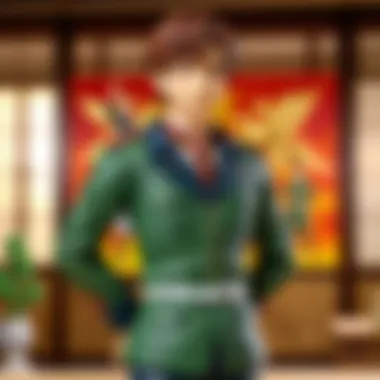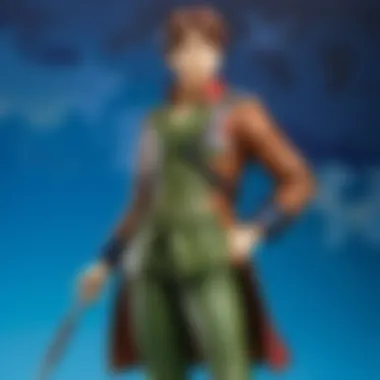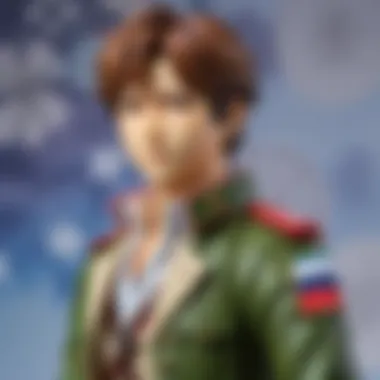The Cultural Evolution of Hetalia in Anime and Merchandise


Intro
Hetalia has taken quite a journey since its inception, weaving together the threads of humor and history. Emerging from the unique perspective of its creator, Hidekaz Himaruya, this series has cultivated a dedicated following, primarily due to its clever portrayal of nations through anthropomorphism. Each character embodies not just a country’s persona but also encapsulates historical and cultural quirks that resonate with fans on various levels.
While humor serves as a primary attraction, the underlying commentary about nationalism and international relations adds layers to the narrative. Understanding this balance has allowed Hetalia to carve out a niche, not just within the anime world but also in a broader cultural context.
As an engaging blend of parody and educational insight, Hetalia’s impact extends beyond its episodes, stretching into the realm of merchandise. From the intricate figures lining the shelves of dedicated collectors to the apparel sporting iconic characters, the series has become a staple in the anime merchandise industry. By examining the cultural significance of Hetalia, we can uncover how it has shaped not only trends in anime but also the collectible market, thus enriching the experience for fans and collectors alike.
The following sections will explore the various facets of Hetalia, its merchandise, and the insights of passionate collectors, guiding readers through the intricate world this series has fostered.
Foreword to Hetalia
Hetalia has etched its name deeply in the realm of anime and pop culture, and it's not hard to see why. By weaving together humor with historical narratives, this series has managed to attract a diverse audience, merging the lines between education and entertainment. This section examines the intricate tapestry that is Hetalia, shedding light on how it evolved from a simple webcomic to a cultural phenomenon. Readers will uncover the appeal of its characters, the interplay of nations personified, and the way these elements resonate with fans across the globe.
Historical Context
To truly grasp the impact of Hetalia, one must consider the historical backdrop from which it emerged. Conceived during a time when cross-cultural communications were burgeoning with the internet, Hetalia appeared as a novel approach to discuss history without the heavy weight often associated with traditional narratives. The series, created by Hidekaz Himaruya in 2006, takes a light-hearted jab at international relations and historical events through the quirky personification of countries.
Throughout the years leading up to its release, global politics were anything but subtle, filled with tensions and alliances that shaped modern history. These nuances provided fertile ground for the comedic interpretations found within Hetalia. For instance, the light-hearted banter between characters representing rival nations isn’t just meant for laughs; it serves as a commentary on stereotypes and misunderstandings that are prevalent in our world.
However, the historical context also needs to recognize the shift in how societies digest information. As younger generations began seeking alternative means of learning, the allure of animated storytelling provided by Hetalia captured attention. The storytelling style, shying away from rigid historical accounts, instead invites viewers to engage with history in a more casual manner, opening up discourse about cultural differences and the complexities of international relationships.
Cultural Significance
Diving deeper, Hetalia serves multiple purposes beyond mere entertainment; it acts as a cultural mirror reflecting societal perceptions of nations through its characters. By personifying countries, the series dives into national stereotypes while allowing audiences to laugh at the absurdities inherent in such broad labels. This way of portraying nations certainly raises eyebrows and stirs discussions about cultural sensitivity—another essential aspect to consider.
The main thread that weaves through Hetalia is the idea that the quirks of nations can unite people through shared laughter, despite differences.
Furthermore, the series promotes cross-cultural dialogue. For fans, it opens avenues for discussing national identity and the historical implications attached to it. The dynamic between countries as portrayed in Hetalia allows viewers to engage in conversations about real-world atrocities and alliances without feeling weighed down by the serious nature of these topics.
As fans flock to the world of Hetalia, one can’t overlook the show's role in bridging gaps between cultures. It gives rise to an awareness of global issues while simultaneously celebrating the uniqueness of each nation. This cultural significance culminates in a vibrant, enthusiastic fanbase that spans the globe, united by their shared interest in both history and anime.
In summary, the cultural landscape of Hetalia not only reflects its historical backdrop but also evolves with current issues, impacting how fans interpret and engage with it. With the popularity of the series continuing to rise, the importance of understanding its cultural and historical nuances cannot be overstated.
Key Themes in Hetalia
When discussing the cultural impact and evolution of Hetalia, it is crucial to understand the key themes that underpin the series. These themes do not only define Hetalia's narrative but also provide insights into the ways it has resonated with audiences, contributing significantly to its popularity and fandom. Themes such as personification of nations, humor and satire, along with the depiction of historical events, frame the series’ unique angle and its wider implications in both anime and merchandise markets.
Personification of Nations
At the heart of Hetalia lies the concept of personification, where countries are represented as anthropomorphic characters. Each character embodies distinct stereotypes and traits culturally associated with their respective nations. This not only serves to entertain but also offers a platform for commentary on national identity and cultural differences. For instance, Italy is often portrayed as carefree and laid-back, while Germany is depicted as strict and orderly.
The success of this approach lies in its ability to spark curiosity. Viewers catch glimpses of historical and cultural backgrounds even without deep knowledge of global history. It encourages fans to delve into their own countries’ traits, fostering cultural appreciation. Additionally, this personification aids in neutralizing tensions around sensitive topics during discussions, as the use of humor softens the blow of potentially controversial narratives.
“Hetalia's personification allows fans to engage with historical events in a playful yet meaningful manner.”
Humor and Satire
Humor is also a vital pillar that shapes Hetalia. From light-hearted jokes to sharp satire, the series uses comedy to critique international relations and historical occurrences. This blend of humor with cultural critique invites fans to not only laugh but reflect on the absurdities present within real-world politics.
The show is replete with quirky situations, often portraying diplomatic meetings with comedic misunderstandings or playful interactions. This comedic lens makes global issues more approachable, especially for younger audiences who may find them daunting. Hetalia exemplifies how laughter can be a tool for education, making complex histories accessible and relatable. It highlights that, despite cultural differences, humor can bridge divides, creating connections among fans from various backgrounds.


Historical Events Depiction
Another noteworthy theme is Hetalia's depiction of historical events. While the series does not claim to be an educational source, it weaves historical context into its narrative tapestry. Significant moments in history are showcased through the actions and relationships of the personified nations.
This interpretative storytelling sparks interest, encouraging fans to explore historical contexts in-depth. Many viewers have found themselves researching events depicted in the series, leading to increased historical awareness. However, critiques arise over the simplification of complex histories. While it can raise questions about accuracy, it opens avenues for discussion, allowing fans to address and analyze historical perspectives as they relate to contemporary world affairs.
In summary, the key themes of personification, humor, and historical events craft a narrative that not only entertains but also enriches the cultural landscape surrounding Hetalia. This thematic richness is pivotal for understanding its significant influence in the anime realm and merchandise markets. Each theme connects seamlessly with fans and collectors alike, proving that Hetalia isn’t merely a series but a conversation starter on history and culture.
Evolution of Hetalia's Popularity
The rise of Hetalia in the anime landscape demonstrates a fascinating shift in how media engages with fans and collectors. Understanding its evolution in popularity reveals not just the series' charisma but also how it resonates with a culture increasingly obsessed with identity representation. The unfolding journey of Hetalia from an online comic to a staple in anime merchandise encapsulates changing paradigms in fandom dynamics and the important aspects of customer engagement.
Initial Reception
When Hetalia first emerged onto the scene, it generated mixed reactions. The initial reception involved both excitement and concern. On one hand, fans were drawn to the anime's playful take on history; its unique portrayal of countries as characters sparked interest. Viewers found joy in how the series turned complex historical interactions into comedic sketches that could challenge any dry history textbook. On the other hand, the humorous personification of nations raised eyebrows. Some critics argued that it trivialized serious historical events, which led to a divide in audience reactions. The online discussions were quite vibrant, especially on platforms like Reddit, where fans shared their interpretations and others questioned the cultural implications.
Growth of Fanbase
Despite the controversies, the fanbase grew like wildfire. The growth can be attributed largely to social media and the way fans connected over Hetalia. As illustrations circulated and fan artwork flourished, the series started to carve out its niche. Platforms like Facebook and Tumblr became hotbeds for meme generation, where fans created characters like Italy and Germany embodying their national stereotypes. The community atmosphere facilitated interaction among fans, with many organizing events to discuss episodes, create fan fictions, and share unique merchandise ideas.
Moreover, conventions dedicated to anime saw significant turnout of Hetalia fans, showing that the series not only attracted viewers but created a culture of shared experience and celebration of its characters. This collective enthusiasm solidified Hetalia’s place in popular culture as a phenomenon, rather than just a passing trend, reflecting a commitment from its fans.
Transition to Merchandise
As the series' popularity surged, the transition into merchandise became inevitable. Collectors began seeking figures, clothing, and other paraphernalia inspired by Hetalia. The shift can be seen as a response to fans wanting to take a piece of the show into their daily lives. Figures of characters like America holding fast food or Japan with his tea became iconic representations that resonated with collectors.
This newfound market presence was characterized by a plethora of product offerings. It wasn't just about conventional merchandise like DVDs and posters anymore; the industry started producing a variety of items, including plushies and limited-edition apparel. The market diversification allowed fans not only to indulge in collecting but also to express personal identities through their favorite character representations.
The evolution of popularity for Hetalia illustrates a significant crossing of boundaries between entertainment and consumerism, showcasing how deeply anime can influence community and cultural expression.
Impact on Anime Merchandise
The influence of Hetalia on anime merchandise has been profound and multifaceted. This series has elevated the standards for what constitutes collectible merchandise in the anime world. Its unique blend of humor, history, and personality characteristics of nations creates a rich tapestry for fan engagement. Ultimately, Hetalia doesn't just serve as entertainment, but rather reshapes collectors' experiences, enhancing their emotional connection to the series.
Figures and Collectibles
In the realm of collectibles, Hetalia has carved a niche that exceptionally resonates with enthusiasts. The figures that depict the various characters are not just plastic toys; they are expressions of identity and national characteristics brought to life. Each character's design often reflects their cultural background, sparking curiosity among fans about the nations they represent.
For example, the Italy figure, often portrayed with a carefree pose and a charming smile, embodies the laid-back lifestyle stereotypical of Italians. In contrast, Germany's figure exudes a sense of seriousness and precision, which echoes his historical traits. These figures not only serve as conversation starters but also deepen collectors' appreciation of the series, creating an emotional attachment to these items.
When collectors invest in these figures, they’re not just buying a piece of merchandise—they’re participating in a cultural dialogue. The production of rare, limited-edition figures frequently creates a buzz, driving up demand and reinforcing the collectible community.
Fashion and Apparel
Beyond figures, Hetalia has significantly impacted the fashion landscape within the anime culture. Apparel featuring iconic characters or phrases from the series taps into fan identity in a manner that transcends standard clothing. T-shirts, hoodies, and accessories emblazoned with Hetalia imagery allow fans to express their passion for the series in their everyday lives.
It's noteworthy to mention that the style of these garments often draws on trends seen in contemporary fashion, helping to blur the line between anime merchandise and mainstream apparel. For instance, a simple shirt might sport an artistic representation of Japan's Sakura Blossoms in the background, coupled with the character's silhouette, creating a tasteful, wearable piece of art.
Diverse Product Offerings
One of Hetalia’s strongest business strategies is its ability to branch into diverse product offerings. From household items like mugs and posters to quirky accessories like keychains and phone cases, the series has proven that its charm lies not just in the core narrative but also in its versatility as a merchandise powerhouse.


Notably, Hetalia merchandise appeals to a broad audience range that includes not only traditional anime fans but also those interested in fashion, collectibles, and even home decor. The series has also seen collaborations with various brands, leading to limited-edition items that create buzz within the fandom.
This kind of diversification highlights the strategic importance of character relevance in product design. Items that showcase prominent scenes or quotes amplify the allure, pulling fans deeper into the universe while offering something that feels personalized, even if it is mass-produced.
Collectibles are more than just objects; they are portals to memories and emotions connected to narratives that shape our understanding of cultures.
End of Impact on Anime Merchandise
In sum, Hetalia’s cultural impact on anime merchandise is multifaceted and substantial. It has reshaped expectations for collectibles, positioned fashion as a form of fan engagement, and diversified product offerings that have captured the hearts of many around the globe. Each step in the journey of Hetalia as a brand reveals an overarching theme: the power of storytelling through various forms of art and commerce.
Controversies Surrounding Hetalia
Hetalia, while loved by many, is not without its share of controversies. The engaging nature of the series, which often utilizes humor to explore historical relationships, dwells in complex territories. Understanding why these controversies are crucial involves dissecting two main areas: cultural sensitivity and historical accuracy. Both elements play a pivotal role not only in shaping the narrative of Hetalia but also in influencing fan engagement and merchandise marketing.
Cultural Sensitivity
Cultural sensitivity is paramount in any discussion related to Hetalia. The series portrays various nations as anthropomorphic characters, often exaggerating stereotypes for comedic effect. This artistic choice, while entertaining to a segment of viewers, raises questions about respect and representation.
Fans sometimes find themselves walking a tightrope. For example, the character of Italy is often depicted as carefree and pasta-loving, which some may see as a light-hearted caricature. But to others, these portrayals can come off as reductive or offensive. Each nationality represented in Hetalia has its unique cultural attributes and historical experiences, and the extent to which these are caricatured can lead to criticism.
"Humor is a double-edged sword; it can unite or divide. Hetalia illustrates that line brilliantly yet precariously."
Mistrust and misunderstanding can arise when the jokes are based on troubling historical events, such as wars and colonization. Some fans have expressed discomfort, feeling that context has been lost in translation, turning historical trauma into a punchline. The response from creators often highlights their intention to foster a comedic medium through caricatures rather than to trivialize real pain.
Thus, the debate hinges not only on the nature of comedy but also on the broader cultural responsibilities of creators in the anime genre. Controversies around these portrayals can sometimes lead to backlash, impacting the reception of new merchandise and adaptations, potentially driving a wedge between fans.
Historical Accuracy
Another critical aspect surrounding Hetalia is historical accuracy. The series often takes liberties with timelines, events, and motivations, which can skew perceptions of history. While some liberties can be fairly harmless, they can also mislead those who are not well-versed in historical facts.
For instance, certain characters like Germany or Japan might be depicted in ways that oversimplify complex historical identities or decisions, which can be misleading for viewers. This issue comes into sharp focus when the series brushes over significant events or contextualizes actions without adequate nuance.
Historian critiques have pointed this out: "While Hetalia's narrative aims to be entertaining, it may unintentionally rewrite certain historical narratives into a format that doesn't do justice to the reality of what transpired."
Moreover, the response from fans showcases a mixed bag. Some viewers embrace Hetalia for what it is—an imaginative portrayal, while others call for accuracy and depth in representing national histories. The success of related merchandise often intertwines with how well the portrayal withstands scrutiny. Collectors may question authenticity when it intersects with their understanding of historical fidelity.
Navigating these concerns can be tricky. Whether art imitates life or vice versa, Hetalia's approach invites an ongoing conversation about the relationship between comedy, culture, and history. As its fanbase continues to evolve, understanding these two critical controversies will prove essential in gauging the series' long-term viability and impact.
Community and Fandom
The world of Hetalia extends well beyond its narrative and humor; it thrives within a vibrant community of fans that plays an essential role in the cultural impact of the series. This fandom is not just a collectivity of people who appreciate the show, but rather a diverse tapestry of creativity, collaboration, and sometimes contention. By digging into the nuances of the Hetalia fandom, we can uncover how it enriches the anime culture and influences the series' evolution in merchandise.
Fan Art and Creativity
Fan art has emerged as one of the most potent expressions of affection within the Hetalia community. Artists worldwide take to their sketchbooks and digital canvases, breathing life into their interpretation of characters who personify nations. Each artwork serves as a unique lens through which fans explore their favorite scenes, relationships, and narratives.
These creative endeavors are not merely for individual enjoyment; they contribute to a collective appreciation of Hetalia's themes. A lot of fan art reflects both humor and critique, much like the series itself. Fans channel contemporary issues, national stereotypes, and historical contexts into their work, often resulting in pieces that spark dialogue and debate.
Additionally, platforms like DeviantArt and Tumblr have become crucial for showcasing this art. They provide a global stage where fans can share their talents, fostering an environment of inspiration and support. Many artists collaborate, creating pieces that blend styles and interpretations, helping to push their craft forward while promoting the Hetalia brand.
Admirers eagerly engage with fan art through comments and shares, which not only boosts artists' visibility but also reinforces a sense of community. It's about forming connections; whether through critiques, collaborations, or casual chats, these interactions forge bonds that often last well beyond the confines of the fandom itself.


Conventions and Gatherings
Conventions and gatherings bring the Hetalia fandom together in a physical space, solidifying connections forged online into real-life friendships. Events like Anime Expo or Comic-Con hold special appeal for Hetalia enthusiasts, offering a chance to celebrate their shared passion for the series. Here, fans engage in various activities that enhance their experience.
- Cosplay: Many fans participate in cosplay, dressing as their favorite characters. The attention to detail in these costumes demonstrates deep love and respect for the representations of nations.
- Panels and Discussions: Organizers often schedule panels where fans can share their interpretations of the show, analyze cultural implications, or engage in heated discussions about themes and characters.
- Merchandise and Art Sales: With numerous booths, conventions double as marketplaces for Hetalia-themed merchandise—from official collectibles to handcrafted items made by talented artisans. These transactions foster support within the community, creating an ecosystem where creativity thrives.
Ultimately, conventions serve as a melting pot of ideas and enthusiasm, where both old and new fans converge. The atmosphere is palpable with excitement, as attendees can interact with fellow fans who share their quirky humor and intense loyalty to the series. It is in these faces and experiences that the true legacy of Hetalia is underscored—a series that not only sparked laughter and reflection but also built a community that stands the test of time.
"Fandoms like Hetalia show us how diverse and passionate a community can be. There's a remarkable bond formed when people connect over shared interests and creativity that can last a lifetime."
In summary, the community and fandom surrounding Hetalia add layers to its cultural impact that mere storytelling cannot achieve on its own. This multifaceted engagement helps sustain the series' relevance in the rapidly evolving landscape of anime.
The Future of Hetalia
The ongoing journey of Hetalia has sparked conversations that go beyond just its humorous take on history. As this series approaches its next chapter, it becomes crucial to analyze how its legacy has set the stage for future endeavors. The combination of historical nuances and lighthearted interactions among characters presents a continuous opportunity for explorations into international relations, and this perspective is not only relevant but essential in our ever-evolving global landscape.
One key area to spotlight is the possibility of new media formats – a focus on potential new releases. Beyond the traditional manga and anime episodes, fans are eagerly anticipating spin-off adaptations, mobile games, and even potential virtual reality experiences that could plunge audiences into the world of Hetalia. Such creations could breathe new life into the series, allowing fans to engage with their favorite characters in an interactive manner.
Moreover, the cultural significance of Hetalia remains steadfast. With shifting political landscapes and complex international relationships, storylines that incorporate current events and diplomatic hilarities would resonate deeply. This could form a bridge connecting historical context with contemporary issues, ensuring that Hetalia stays relevant to both old and new fans alike. The artistic representation of nations can evolve accordingly, echoing the changes in global dynamics.
Potential New Releases
As the horizon for Hetalia's future unfolds, enthusiasts are rightfully buzzing about new content. There’s a shared hope amongst fans for fresh anime episodes or a continuation of the manga series. Over the years, Hetalia has succeeded in playing with various artistic styles. This creativity could be harnessed to explore different genres – imagine a Hetalia horror special or even a slice-of-life series where the nations delve into their personal lives.
Fans have also expressed keen interest in merchandise collaborations, particularly within the realm of video games. Interactive storytelling through platform games or visual novels focused on Hetalia characters could keep fans engaged.
The potential for animated films is another avenue that many believe would cater to the audience’s nostalgia and dreams of vibrant storytelling. The success of other anime films has proven that there's a solid market for such releases.
Evolving Trends in Anime Merchandise
The merchandise surrounding Hetalia has always reflected its ever-changing fandom. From plush dolls to collectible figures, the sprawl of offerings suggests a thriving economy within anime merchandising. Moving forward, it’s vital to embrace current trends in product development, satisfaction, and creativity. Fans’ preferences are shifting towards more personalized and limited-edition items, which opens the door for creators to experiment with unique pieces.
Products that integrate sustainable materials or exhibit ethical production processes may also attract today's environmentally-conscious collectors. Additionally, collaborations with popular fashion brands could present opportunities to merge Hetalia aesthetics with everyday wear – capturing a broader audience while maintaining the playful spirit of the original content.
Over time, Hetalia merchandise has depicted a strong cultural narrative, and the future holds potential for even deeper storytelling through collectibles. Articulating narratives through figures that embody historical contexts can spark discussion, deepen appreciation, and unite fans around shared experiences. This aligns not only with the trends of today’s markets but also fortifies the link between fandom and economic sustainability.
"The strength of Hetalia's future resides in empowering connections across cultures through humor, history, and creativity."
As Hetalia moves forward, fans and collectors alike must stay vigilant about what the future holds – it promises to be a tantalizing mix of fresh artistic expressions and innovative merchandise that respects both its origins and the new milieu it must navigate.
The End
The conclusion of any analysis serves as the final word on the subject matter, summing up complexities and highlights. In the case of Hetalia, this conclusion is pivotal not just for understanding the series itself but for recognizing its broader cultural impact. Several key elements shed light on why this particular slice of anime deserves attention.
Firstly, Hetalia's ability to mix humor with historical narrative creates a unique space in anime, allowing it to reach audiences who might otherwise shy away from traditional historical discourse. It becomes more than just a show; it serves as a cultural commentary that reflects on nationalism, stereotypes, and international relationships.
The series has sprouted a dedicated fanbase, eager to engage with both the comedic takes on history and the persona of nations. Fan art, conventions, and online communities have fueled discussions and creativity, enhancing its legacy over time.
Moreover, the merchandise aspect can't be ignored. From figures depicting Italy and Germany in endearing poses to apparel that fans wear with pride, Hetalia has created a sub-market that intertwines with the larger anime industry. This evolution of merchandise serves not only to satisfy collectors but also to engage new audiences.
Reflecting on its impact requires a critical lens. Not everything in Hetalia's wake is universally praised. The controversial elements tied to cultural sensitivity and historical representation invite ongoing conversation. These factors further contribute to the character of the brand, pressing fans and scholars alike to reckon with its imperfect portrayal of events and people.
Understanding these varied dimensions paints a clearer picture of Hetalia's significance. It stands as a cultural artifact that documents not just international opinions but changing identities in a globalized world. The interplay between comedy, history, and collectible merchandise encapsulates a much larger narrative—a narrative that is still evolving.
"Cultural impacts are seldom linear; they intertwine and shape one another, creating a tapestry rich with meanings and interpretations."
In summary, Hetalia's legacy is multifaceted, weaving together threads of entertainment, cultural conversation, and consumer behavior. As we look to the future, it'll be intriguing to see how this series continues to navigate the waters of global culture, leaving a mark not only on anime but on the collective consciousness of its audience.



